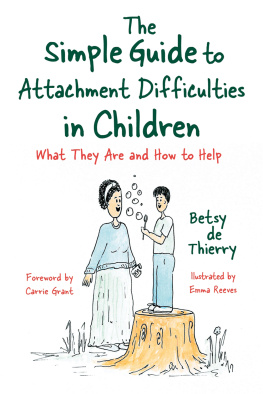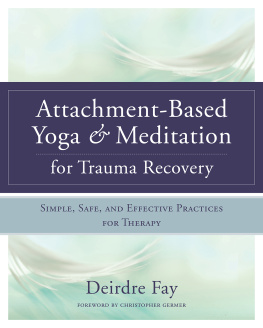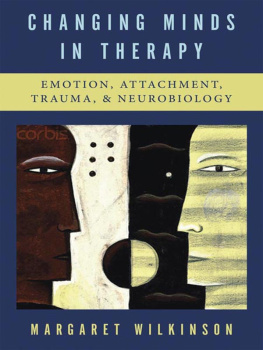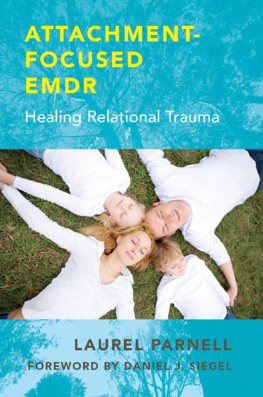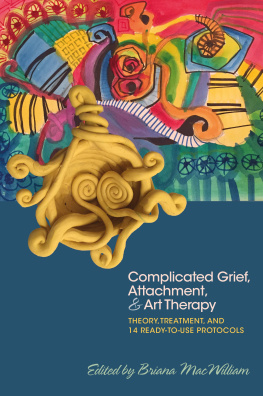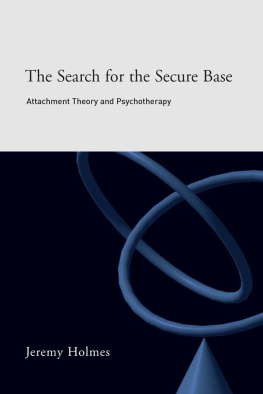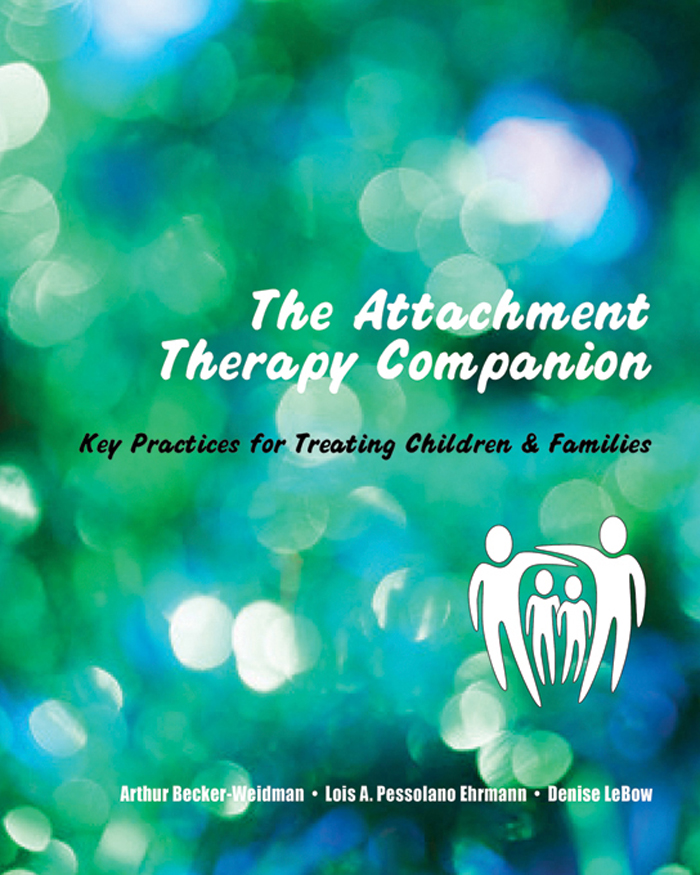The Attachment Therapy Companion
A NORTON PROFESSIONAL BOOK
The Attachment Therapy Companion
Key Practices for Treating Children & Families
ARTHUR BECKER-WEIDMAN
LOIS EHRMANN
DENISE LEBOW

W. W. NORTON & COMPANY
New York London
Copyright 2012, 2009 by Association for Treatment and Training in the Attachment of Children
Previous edition published under the title
ATTACHMENT-FOCUSED THERAPY: A Professional Practice Guide
All rights reserved
For information about permission to reproduce selections from this book, write to Permissions, W. W. Norton & Company, Inc., 500 Fifth Avenue, New York, NY 10110
For information about special discounts for bulk purchases, please contact W. W. Norton Special Sales at specialsales@wwnorton.com or 800-233-4830
Book design by Gilda Hannah
Production manager: Leeann Graham
Library of Congress Cataloging-in-Publication Data
Becker-Weidman, Arthur, 1953
The attachment therapy companion : key practices for treating children & families / Arthur Becker-Weidman, Lois Pessolano Ehrmann, Denise LeBow.
p. cm.
A Norton professional book.
Previous edition published under the title Attachment-focused therapy:
a professional practice guideT.p. verso.
Includes bibliographical references and index.
ISBN 978-0-393-70748-9 (pbk.)
1. Attachment disorder--Treatment. 2. Family psychotherapy. I. Ehrmann, Lois Pessolano. II. LeBow, Denise. III. Title.
RC455.4.A84B43 2012
616.8588dc23
2011049616
ISBN: 978-0-393-70748-9 (pbk.)
eISBN 978-0-393-70800-4
W. W. Norton & Company, Inc., 500 Fifth Avenue, New York, N.Y. 10110
www.wwnorton.com
W. W. Norton & Company Ltd., Castle House, 75/76 Wells Street, London W1T 3QT
1 2 3 4 5 6 7 8 9 0
This book is dedicated to the many families with whom we have had the privilege of working.
They have taught us much and we hope this book reflects what we have learned.
CONTENTS
ACKNOWLEDGMENTS
We would like to acknowledge the members of the Association for Treatment and Training in the Attachment of Childrens Professional Practice Manual Committee who prepared the original draft of this book, under the leadership of chairperson Victoria Kelly, PhD, past president of the association. This committee worked for over a year reviewing best practices, current research, and trends to prepare the early version of this book. Under the leadership of Dr. Kelly, that document became a nationally recognized standard. It is with deep appreciation that we would like to thank the committee for its groundbreaking work.
I would also like to thank the board of directors of ATTACh for allowing me, along with my colleagues Denise and Lois, the opportunity to offer readers a revised edition. This dedicated group of individuals has been a source of support and inspiration to me and I value their friendship. For over ten years I have been associated with ATTACh and am pleased to have had this opportunity to help the organization.
On a personal note, I must acknowledge my family. Without the support of my spouse, Susan, and my children, Emily, David, and Samantha, I could not have completed this work. Their understanding of my many hours attending to this manuscript gave me the peace necessary to complete the work.
Finally, I thank Lois and Denise for their hard work on this project. Each of them took responsibility for particular chapters, and their work resulted in a substantially new and improved professional resource. I am grateful for their efforts and their friendship.
Arthur Becker-Weidman, PhD, November 1, 2011
ORIGINAL COMMITTEE MEMBERS
Arthur Becker-Weidman, PhD
Chris Diani, LCSW
Lois P. Ehrmann, PhD, NCC, LPC, CAC
Victoria Kelly, PhD
Keith Kuboyama, LCSW
Todd Nichols, MA, MPAff
Sally Popper, PhD
PREFACE
This book began as a project of the Association for Treatment and Training in the Attachment of Children (ATTACh), the first edition of which the organization published over 3 years ago. Since then, a number of advances in the treatment of complex trauma and disorders of attachment have occurred. My colleagues, Denise LeBow and Lois Ehrmann, and I have worked hard to update and improve that document.
I would like to highlight several points for readers with regard to this new, re-titled edition, which has been substantially edited and updated. We have added many new, more current references and citations to support the latest emerging research on attachment and trauma. We have worked hard to include a good deal of new, up-to-date material and case examples that reflect cutting-edge knowledge of the nature of attachment disorders and complex trauma. We have included more recent research and materials about complex trauma, the neurodevelopmental treatment implications of trauma, and new treatment information that describes, in attachment theory terms, the phases of treatment within a relational model. This new material greatly expands the range of options for clinicians. For example, a better understanding of the phases of treatment and the importance of creating an alliance and safe base enables clinicians to use various interventions differentially, depending on the phase of treatment and the childs neurodevelopmental functioning.
The order of chapters has also been changedand some chapters combinedto create a more user-friendly flow to the material. The reader will find that the reference section is much expanded, as is the study guide (Appendix D).
This book is an important contribution to the field of trauma treatment and attachment-focused therapy. It provides clinicians with a framework to assess, develop, and evaluate treatment plans, and to provide treatment in a comprehensive and integrated manner. Judges, attorneys, and child welfare professionals will find this book quite helpful in their work. It provides a comprehensive description of the standards of care for evaluations and treatment within an ethical framework. The material in this book can be used to evaluate the adequacy of evaluation and treatment, and act as a guide when service decisions are being made. College professors will also find this book a useful adjunct for family therapy, treatment, and ethics classes, and the study guide will assist in classroom instruction. Consumers and clients are provided the necessary tools and information to make better-informed decisions regarding the adequacy of care they are getting. It is my hope that this book will mark a new stage in the development of attachment-focused therapy by delineating the standards of care for the treatment of attachment and trauma disorders.
Arthur Becker-Weidman, PhD, November 1, 2011
The Attachment Therapy Companion
Introduction
Attachment-Focused Therapy Today
Attachment-focused therapy is based on improving the relationship between child and caregiver, so that the caregiver can be a resource and a source of safety, comfort, and security to the child. For the purposes of this book, the term caregiver applies to whomever is caring for the child: parent (birth, foster, or adoptive), primary youth worker in residential settings, or other custodial guardians, depending on the circumstances of the case.
Our purpose in writing this book is to provide the reader with a comprehensive text describing the principles, components, and framework of attachment-focused therapy. While much of the book is focused on providing attachment-focused therapy for families of children with trauma and attachment disorders, the general framework described in this book can be used with a variety of other populations and problems. This book provides the practitioner of attachment-focused therapy with the necessary guidelines for the ethical and professional practice of this very complex and rewarding treatment approach.



